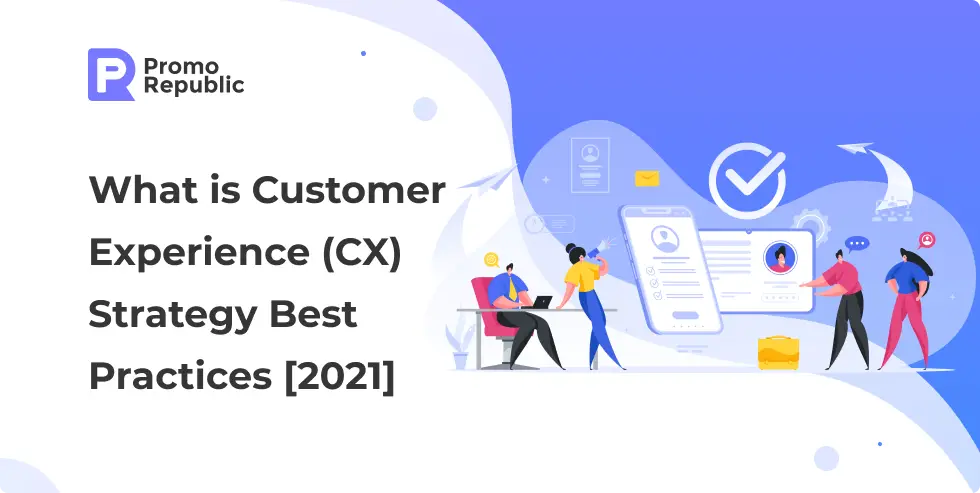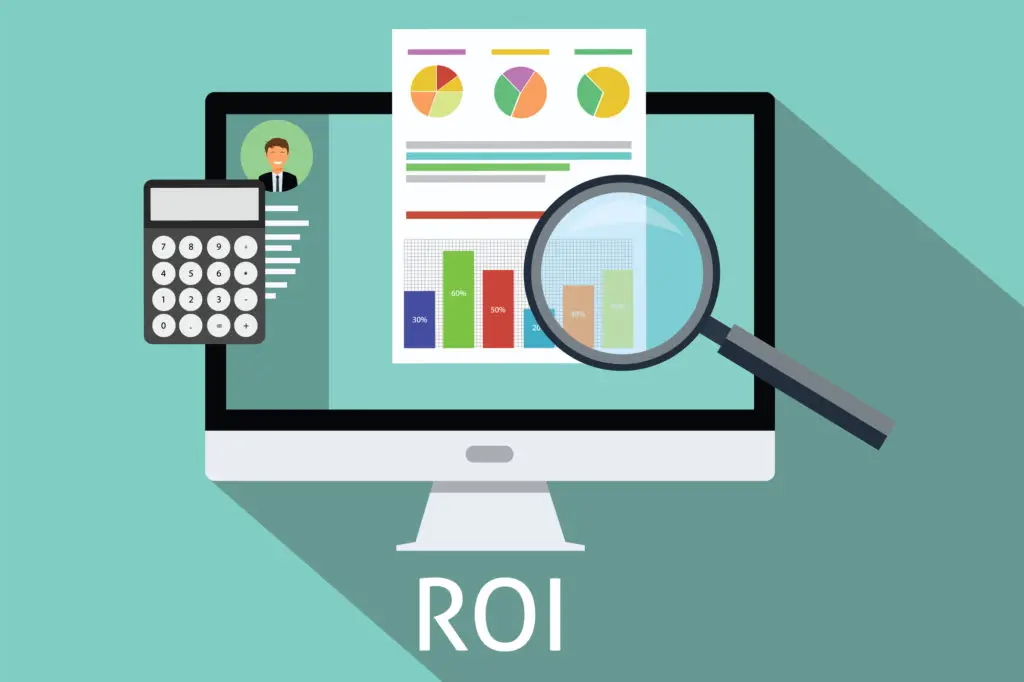What is Customer Experience (CX) Strategy Best Practices [2021]

Content writer and blog editor at PromoRepublic
Consumers are becoming increasingly used to demanding more from businesses. The rise of digital transformation has resulted in a far more knowledgeable and demanding consumer base.
Soon, the key brand differentiator will be customer experience, not price or product. It puts more pressure on businesses to strike a balance between the experience they want to deliver and their limited internal resources.
Having a great Customer Experience (CX) Strategy aids in having a positive customer experience. However, it requires a customer-centric mindset as well as extensive planning.
In this article, you’ll learn the definition of Customer Experience (CX) Strategy, its importance, metrics, and guidance on how to create one.
What is a Customer Experience (CX) Strategy?
Customer Experience (also known as CX) Strategy is an overall assessment of customers’ experiences with your brand. The plan you put in place to deliver positive experiences across each customer touchpoint, as well as the strategic techniques to measure those interactions, make up a customer experience strategy.
Why is Customer Experience (CX) Strategy Important?
Customer experience is crucial since it has an impact on a company’s net profit. A customer who has a positive experience with a company is more likely to return and become a loyal customer. Brand loyalty, customer retention, and lifetime value are all affected by how customers feel about your company.
In increasingly competitive markets, attracting and retaining consumers is a challenging task. Companies that overlook the necessity of delivering a seamless, effective customer experience risk losing out to competitors. Finding a brand alternative has never been easier than it is in 2021, which is why you should always be mindful of the customer experience you deliver.
As a result of the growing market saturation, many businesses understand that customer experience is their best chance to differentiate themselves from others. If a good product and competitive pricing aren’t enough to keep customers loyal, a positive customer experience will be required.
How to Measure it?
It should come as no surprise that knowing how your consumers feel about your product, brand, or service is critical to a successful customer experience strategy. However, how can you know what your consumers genuinely think and say about your business? Are you getting feedback on their first impressions of your brand and tracking how they feel about you over time? The information that your consumers are willing to share with you can be the most valuable data for improving your brand and customer experience strategy.
The first step in gathering and measuring customer feedback data is deciding which CX metric is best for your business goals. Whether you want to track customer satisfaction (CSAT) on a five-point scale or evaluate your company’s Net Promoter Score (NPS), choose from a variety of customer survey templates to automate the delivery of client feedback surveys. Consider mapping out the customer journey and creating customer profiles to augment your CX strategy development goals if you want to take your plan even further at this point.
The following are the important customer experience (CX) metrics:
Customer Satisfaction Score (CSAT). Measuring customer satisfaction allows you to learn more about your customers and what they think of you. Send satisfaction surveys to your consumers asking about their satisfaction with the product or service to discover CSAT.
Net Promoter Score (NPS) is a metric that assesses customer satisfaction and determines how likely your customers are to suggest you to their friends and family. You can also send satisfaction surveys to your consumers to gather NPS data.
Customer Effort Score (CES) measures how satisfied customers are with your products or services and evaluates customer experience. Customers can rate the ease of doing business with your company on a five-point scale ranging from “Very Difficult” to “Very Easy”.
Goals
The first step in improving customer experience should be to determine what you want to achieve. Great customer experience is a strategic goal for improving sales and revenue. It can be achieved by giving customers more control, forming partnerships that improve customer experience, defining target markets, and so on. There are several mistakes to avoid in this process, including failing to account for insufficient consumer data, a lack of business data, and assuming that all customers in your target group have the same viewpoints.
How to Build Customer Experience (CX) Strategy
1. Analyze your current customer experience strategy
Assessing your company’s current customer experience strategy is the first step in designing a customer experience strategy. The aim is to determine what is working well for your company and where you can improve.
If you’re not sure where to begin, look for important metrics such as Customer Satisfaction Score (CSAT), Net Promoter Score (NPS), Customer Effort Score (CES), customer lifetime value, and customer turnover rate. If your score falls short of expectations, you’ll have a starting point for further investigation.
2. Create a clear vision
The creation of a clear customer-centric vision that you can share with your team is a critical step in building a customer experience strategy. Creating a set of statements that serve as guiding principles is the simplest way to define this vision.
Once these principles are in place, they will guide your company’s actions. These principles should be known by heart by every member of your team, and they should be incorporated into all aspects of training and development.
3. Define your target audience
The next stage in building a successful customer experience strategy is defining your target audience and creating a target persona description.The target persona is a detailed description of the type of customer you want to attract.
Segmenting your clients and creating personas is one approach to understand customer needs and wants. It also helps to identify pain points in the buying process. Make an effort to give each character a name and a personality.
4. Create a customer journey map
A customer journey map is another important component of your customer experience strategy. A customer journey map illustrates all of a client’s interactions with your company, including any pain points experienced along the way. This map tells you how to identify and reduce problems in your client experience and how to replace it with satisfaction.
5. Identify customer expectations
Even if some customers have basic expectations of your brand, the majority of customers have unique needs that alter often. In some cases, it may be critical to answering fast, while in others, quality and clarity are more important. It all depends on the customer’s mood when they have contact with your business, as well as your team’s ability to recognize and respond to their requests.
6. Provide customer-centered problem solving experience
A strong customer service approach focuses on resolving customer problems, whether they are anticipated or unanticipated. When we think of customer service, we usually picture call centers and IT staff answering phones 24/7. Many organizations, on the other hand, have teams dedicated to anticipating potential problems and preventing them from affecting customers.
They are called customer success teams, and they’re an important part of delivering a great customer experience. They not only plan for problems down the road, but they also follow up with consumers regularly to check if everything is going well after the sale. This form of proactive customer service decreases client turnover and builds the bond between your team and your customers.
7. Collect feedback regularly
Customer feedback gives you insight into your consumers’ expectations and how they can alter over time as your industry changes. It can also inform you where clients get stuck and what’s functioning well.
You must ask and, more importantly, listen to your customers if you want to genuinely understand what they want from your company. If you ask at the right time, your consumers are more likely to submit a review, but you must take this information seriously and incorporate it into your strategy.
8. Measure the ROI
Finally, how can you know whether all of your efforts to improve your teams, processes, and technology are paying off? The solution can be found in the business results.
One of the most difficult challenges businesses have is determining how to assess customer satisfaction, which is why many companies use measures like Net Promoter Score, which we discussed earlier.
Customer Experience Management
Customer experience management is the process of developing and reacting to customer interactions in such a way that they meet or exceed their expectations, resulting in increased customer satisfaction, loyalty, and support.
Companies that fail to manage the customer experience effectively generally use a fragmented approach, in which they examine the various aspects that influence the customer experience and determine how each one can be improved. They aren’t paying enough attention to how each aspect affects the others while doing so.
Customer Service
Customer service is usually the first department to interact with a customer after a sale. The support team can get real-time feedback on the customer experience by watching how customers interact with the product, how (and if) expectations are satisfied, and how the client base changes. Customer feedback is the most important aspect of the customer experience; without it, organizations cannot effectively evolve.
Product
A business gives the customer experience, and the goods and services are deeply intertwined. Many customers will pay more for an experience than the product they are receiving.
Beyond the immediate experience, the customer experience is influenced by factors such as reliability, accessibility, user experience, general ease of use, and the product’s life cycle. The product’s experience is the most important factor in a company’s reputation, which affects every other aspect of the customer experience.
Marketing
Marketing must continually modify to meet changing customer needs. Advertisements, outbound marketing, and word-of-mouth are frequently used by marketers to make the first impression on a prospect. Their impact is maintained by public relations, social media marketing, and the development of a brand identity. The information obtained from all of these consumer touchpoints can help you build more tailored customer experiences, which leads to increased customer loyalty.
Sales
Aside from fast sale interactions, the sales process is frequently focused on the customer journey and addressing the demands of prospects.
This gives useful information regarding consumer preferences. It can be particular features, follow-ups, support requirements, and so on, all of which could have an impact on other sections of the business. When your customer experience is in harmony, salespeople are better equipped to close repeat sales and lower turnover rates.
Wrapping up
After reading our article, you should be convinced that customer experience is important. Any business, regardless of its size, must invest in a positive customer experience. Above all, your ability to keep and gain loyal customers is crucial to your business’s success. Remember, if you don’t prioritize your customers, they may switch to a competitor.










